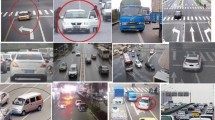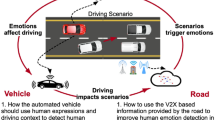Abstract
This work introduces a novel design for an automotive full-windshield head-up display (HUD) interface which aims to improve the driver’s spatial awareness and response times under low visibility conditions. To fulfil these requirements, we have designed and implemented a working prototype of a human–machine interface (HMI). Particular emphasis was placed on the prioritisation and effective presentation of information available through vehicular sensors, which would assist, without distracting, the driver in successfully navigating the vehicle under low visibility conditions. The proposed interface is based on minimalist visual representations of real objects to offer a new form of interactive guidance for motorway environments. Overall, this work discusses the design challenges of such a human–machine system, elaborates on the interface design philosophy and presents the outcome of user trials that contrasted the effectiveness of our proposed HUD against a typical head-down display (HDD).







Similar content being viewed by others
References
Cacciabue PC (2004) Guide to applying human factors methods, human error and accident management in safety critical systems. Springer, London
Charissis V, Arafat S, Chan W, Chistomanos C (2006) Driving simulator for head-up display evaluation: driver’s response time on accident simulation cases. In: Proceedings of Driving Simulator Conference 2006, Asia/Pacific, Tsukuba, Japan
Charissis V, Arafat S, Patera M, Chistomanos C, Chan W (2007) AI for driving simulator vehicles and accident events. To be presented in the Proceedings of the International Conference on Artificial Intelligence and Applications, AIA’07, Innsbruck, Austria
Charissis V and Papanastasiou S (2006) Design and evaluation of an automotive full-windshield head-up display interface: low visibility guidance and navigation. In: Proceedings of the 6th International Conference on Visualisation, Imaging and Image Processing, VIIP’06, Palma de Mallorca, Spain, pp 49–55
Daganzo CF (2000) A behavioral theory of multi-lane traffic flow. Part I: Long homogeneous freeway sections. Department of Civil and Environmental Engineering and Institute of Transportation Studies University of California, Berkeley, US
Fukano J, Okabayashi S, Sakata M, Hatada T (1994) Automotive head-up displays for navigation use. In: Proceedings of 14th International Technical Conference on Enhanced Safety of Vehicles, Paper No. 94-S2-O-02
Gould JD, Lewis CH (1985) Designing for usability: key principals and what the designers think. Communications of the ACM
Gish KW, Staplin L (1995) Human factors aspects of using head-up displays in automobiles: a review of the literature. National Highway Traffic Safety Administration (DOT HS 808 320), Washington, DC
Kenny T, Anthony D, Charissis V, Darawish Y, Keir P (2004) Integrated vehicle instrument simulation: i-ViS initial design philosophy, 3rd International Conference on Total Vehicle Technology, Brighton, UK, pp 93–102
Kiefer RJ, LeBlank DJ, Palmer MD, Salinger J, Deering RK, Shulman MA (1999) Development and validation of functional definitions and evaluation procedures for collision warnings/avoidance systems, Final Report for U.S. Department of Transportation, NHTSA Technical report, Washington, DC
Kiefer RJ, Cassar MT, Flannagan CA, LeBlanc DJ, Palmer MD, Deering RK and Shulman MA (2003) Forward collision warning requirements project Task 1 final report: refining the CAMP Crash Alert Timing Approach by Examining ‘Last-Second’ Braking and Lane-Change Maneuvers Under Various Kinematic Conditions. Interim Report, NHTSA, USDOT, Washington, DC
McCann RS, McCandeless JW (2003) Human–machine teaming for dynamic fault management in next-generation launch vehicles. In: Proceedings of the Joint Army-Navy-NASA-air Force (JANNAF) 3rd Modeling and Simulation Subcommittee Meeting. Colorado Spring
Nelson T (1980) Interactive systems and the design of Virtuality, Creative Computing, US
Preece J, Rogers Y, Sharp H (2002) Interaction design: beyond human-computer interaction. Wiley, New York
Recarte AM, Nunes ML (2003) Mental workload while driving: effects on visual search, discrimination, and decision making. J Exp Psychol Appl 9(2):119–137
Ross T, Burnett G (2001) Evaluating the human–machine interface to vehicle navigation systems as an example of ubiquitous computing. Int J Hum Comput Stud 55:661–674. doi:10.1006/ijhc.2001.0495
Rubinstein R, Hersh H (1984) The human factor: designing computer systems for people. Digital Press, Woburn, MA
Shekhar S, Coyle MS, Shargal M, Kozak JJ and Hancock PA (1991) Design and validation of head up displays for navigation in IVHS, Vehicle Navigation and Information System Conference Proceedings, Warrendale, pp 537–542
Smith DL, Najm WG, Lam AH (2003) Analysis of braking and steering performance in car-following scenarios, Society of Automotive Engineers
Strathclyde Police Department (2004) Accident Statistics 2001–2004, Glasgow, UK
Ward NJ, Parkes AM (1994) Head-up displays and their automotive application: an overview of human factors issues affecting safety. Int J Accid Anal Prev 26(6):703–717
Ward NJ, Parkes A (1995) The effect of automotive head-up display on attention to critical events in traffic. International conference on Experimental Analysis and Measurement of Situation Awareness, Daytona Beach, Florida
Wilde GJS (1994) Target risk. PDE Publication, Toronto
Acknowledgments
The main financial support for this research project has been provided by the Engineering and Physical Sciences Research Council (EPSRC) and National Scholarships Foundation (IKY). User trials for this work were carried out in the E-motion Lab, which was graciously donated by the School of Computing and Mathematical Sciences of Glasgow Caledonian University. Finally, we would like to express our gratitude to the Traffic Police Officers of the Strathclyde Police Department for their valuable contribution during the implementation of this research.
Author information
Authors and Affiliations
Corresponding author
Rights and permissions
About this article
Cite this article
Charissis, V., Papanastasiou, S. Human–machine collaboration through vehicle head up display interface. Cogn Tech Work 12, 41–50 (2010). https://doi.org/10.1007/s10111-008-0117-0
Received:
Accepted:
Published:
Issue Date:
DOI: https://doi.org/10.1007/s10111-008-0117-0




